 The preparation of food for cooking is probably more important and more time-consuming in Chinese cookery than in any other cuisine. Although many dishes are cooked rapidly, this presupposes that every ingredient has been properly prepared beforehand and has been chopped into smallish, well shaped pieces to ensure even and quick cooking. This means that food can be cooked for a minimum of time so that it retains its natural texture and taste. The other reason for careful cutting is to enhance the visual appeal of a dish.
The preparation of food for cooking is probably more important and more time-consuming in Chinese cookery than in any other cuisine. Although many dishes are cooked rapidly, this presupposes that every ingredient has been properly prepared beforehand and has been chopped into smallish, well shaped pieces to ensure even and quick cooking. This means that food can be cooked for a minimum of time so that it retains its natural texture and taste. The other reason for careful cutting is to enhance the visual appeal of a dish.
This is why most Chinese cooks are so specific about cutting techniques, particularly where vegetables are concerned. The Chinese always use a cleaver for these tasks, wielding it with skill and dexterity. Of course a sharp knife can be used instead.
Chinese cookery is a sophisticated cuisine which involves a number of cooking methods which are relatively uncommon in the West. Sometimes several different techniques are used in the preparation of a single dish. Most can be easily mastered with a little practice. When you are planning a meal, be sure to select dishes which use a range of techniques, and limit yourself to one stir-fried dish per meal until you have become used to this important method of cooking.
Cutting techniques
Slicing
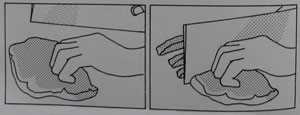
This is the conventional method of slicing food. Hold the food firmly on the chopping board with one hand and slice the food straight down into very thin slices. Meat is always sliced across the grain to break up the fibres and to make it more tender when it is cooked. If you use a cleaver rather than a knife for this, hold the cleaver with your index finger over the far side of the top of the cleaver and your thumb on the side nearest you to guide the cutting edge firmly. Hold the food with your other hand, turning your fingers under for safety. Your knuckless should act as a guide for the blade.
Horizontal or flat slicing

This is a technique for splitting food into two thinner pieces while retaining its overall shape. It is often used for cutting kidneys. The cleaver with its wide blade is particularly suitable for this. Hold the blade of the cleaver or knife parallel to the chopping board. Place your free hand on top of the piece of food to keep it steady. Using a gentle cutting motion slice sideways into the food. Depending on the recipe you may need to repeat this process, cutting the two halves into further thin flat pieces.
Diagonal slicing
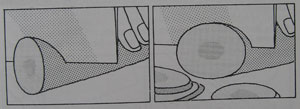
This technique is used for cutting vegetables such as asparagus, carrots or spring onions. The purpose is to expose more of the surface of the vegetable for quicker cooking. Angle the knife or cleaver at a slant and cut.
Roll cutting
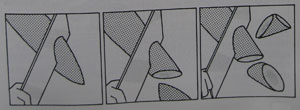
This is rather like diagonal slicing but is used for larger vegetables such as courgettes, large carrots, aubergines and Chinese white radish (mooli). As with diagonal slicing this technique allows more of the surface of the vegetable to be exposed to the heat, thereby speeding up the cooking time. Begin by making one diagonal slice at one end of the vegetable. Then turn it 180 degrees and make the next diagonal slice. Continue in this way until you have chopped the entire vegetable into evenly sized, diamond-shaped chunks.
Shredding
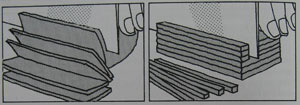
This is the process by which food is cut into thin, fine, matchstick-like shreds. First cut the food into slices and then pile several slices on top of each other and cut them lengthways into fine strips. Some foods, particularly meat and chicken breasts, are easier to shred if they are first stiffened slightly in the freezer for about 20 minutes.
Dicing
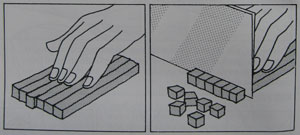
This is a simple technique of cutting food into small cubes or dice. The food should first be cut into slices. Stack the slices and cut them again lengthways into sticks just as you would for shredding. Stack the strips or sticks and cut cross ways into evenly sized cubes or dice.
Mincing
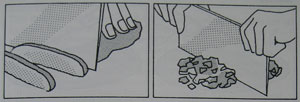
This is a fine-chopping technique. Chefs use two cleavers to mince, rapidly chopping with them in unison for fast results. One cleaver or knife is easier for the less expert although the process will of course take a little longer! First slice the food and then, using a sharp knife or cleaver, rapidly chop the food until it is rather spread out over the chopping board. Scrape it into a pile and chop again, and continue chopping until the food reaches the desired state. You may find it easier to hold the knife or cleaver by the top of the blade (rather than by the handle) with two hands, as though you were chopping parsley. A food processor may also be used for this but be careful not to over-mince the food or you will lose out on texture and taste.
Chopping

This is a term which is used for any technique which requires food to be completely cut through. Usually this applies to whole birds or to cooked food with bones which need to be cut into smaller pieces. The food to be chopped should be placed on a firm cutting surface. Use a straight, sharp, downward motion with the cleaver or knife. To chop through bones, hit down with the blade and then finish off the blow with the flat of your other hand on the top edge of the cleaver or knife. A heavy-duty cleaver or knife is best for these tasks.
Scoring

This is a technique used to pierce the surface of foods to help them cook faster and more evenly. It also gives them an attractive appearance. Use a cleaver or a sharp knife and make cuts into the food at a slight angle to a depth of about 1/8 inch (33mm). Take care not to cut ail the way through. Make cuts all over the surface of the food cutting criss-cross to give a wide, diamond-shaped pattern.

